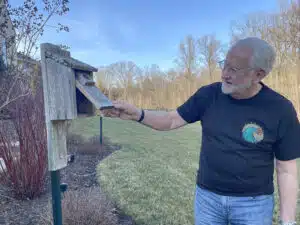 Your Neighbors Are Claiming New Homes in The Grant Village
Your Neighbors Are Claiming New Homes in The Grant Village
Early in March, ten new homes were completed in The Grant Village of Willowsford. Demand for these new homes was very competitive. Prospective residents were flocking in to see them and explore the spacious interiors and appealing exteriors. By late-March most of these new homes were occupied and new families settled in. You are invited to stop by and greet the new families!
Who are these new residents? They are Eastern Bluebirds (Sialia sialis). Bluebirds reside and breed throughout Loudoun County and across America. Willowsford is a favorite spot with its open fields and meadows, wooded conservancy acreage, streams and ponds. The Bluebird is a “cavity nester”, preferring holes left behind by nesting woodpeckers or similar, naturally occurring openings in trees. But they are intelligent innovators and will use almost any protected and elevated cavity space: Mailboxes, empty containers, and especially nest boxes built, erected, and monitored by people dedicated to increasing the Bluebird population.
In past years, the Bluebird was threatened with extinction due to pesticides and dramatic loss of woodland and grassland habitats due to development and urbanization. Additionally, with the introduction of non-native bird species such as House Sparrows and European Starlings, bluebirds lost the scarce cavity dwellings to the more aggressive invaders. But conservationists supporting such organizations as the Loudoun Wildlife Conservancy, Virginia Bluebird Society and, of course, The Willowsford Conservancy, began an earnest effort to erect protected nesting boxes and track the progress of maintaining and expanding the Bluebird population.
In 2004 I got involved with Bluebirds when my daughter needed a challenging project to complete her Girl Scout Gold Award qualifications. Her research led her to the loss of Bluebirds and the need for more protected nesting boxes to save the population. She organized and led a project, adopted by Eleanor C. Lawrence Park in Fairfax County, that installed about 15 Bluebird Nesting Boxes on a trail through a portion of the Park. Afterwards, I installed 2 boxes at my home and have been watching them ever since. When I moved to Willowsford, I left those boxes behind, but installed 2 boxes in my new backyard in 2016. And the Bluebirds promptly moved in.
Loudoun Wildlife Conservancy has 698 boxes, located on 57 public trails throughout Loudoun County. Over the last few years, volunteer monitors documented more than 1,450 fledged, baby Bluebirds annually. And March is the month that Bluebird pairs, which observations indicate mate for life, select a new nest cavity or return to a previous, favorite nest. And from personal experience, I can tell you they often come back to the same box year after year. They produce 1-3 clutches of eggs over the season (early March through early September). Each clutch can have 2-7 eggs. That averages roughly 10-15 baby birds per season per mated pair.
Would you like to be one of our volunteers to assist with monitoring these nesting boxes? Willowsford now has three established Bluebird Nest Box Trails with a total of 29 boxes. One trail is located in The Grove (by Pin Oak Park), one trail in The Grange ( around the Farm Loop) and one trail in The Grant ( by the trail along Allen Farm Pond). All trails are well developed and easily accessible. One box in The Grant is now installed in the Everfield Community Park.
To Volunteer to help monitor these new Grant Village Boxes, use this link here. Volunteers receive training and the monitoring periods are once a week throughout the March-August nesting period. Essentially, it’s a walk along the trail, checking 10 boxes and noting various activities and conditions of each box. It can be a fun family walk and a great learning experience.
This Agrihood Voice has been brought to you by:
Charles W. Graybeal
Resident, The Grant Village, Willowsford

